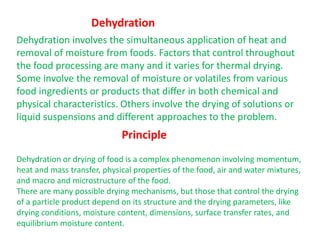
Dehydration-1.pptx
- 1. Dehydration involves the simultaneous application of heat and removal of moisture from foods. Factors that control throughout the food processing are many and it varies for thermal drying. Some involve the removal of moisture or volatiles from various food ingredients or products that differ in both chemical and physical characteristics. Others involve the drying of solutions or liquid suspensions and different approaches to the problem. Dehydration Principle Dehydration or drying of food is a complex phenomenon involving momentum, heat and mass transfer, physical properties of the food, air and water mixtures, and macro and microstructure of the food. There are many possible drying mechanisms, but those that control the drying of a particle product depend on its structure and the drying parameters, like drying conditions, moisture content, dimensions, surface transfer rates, and equilibrium moisture content.
- 2. I. Liquid diffusion: if the wet solid is at a temperature below the boiling point of the liquid II. Vapor diffusion: if the liquid vaporizes within material III. Condensation diffusion : if drying takes place at very low temperatures and pressures, e.g., in freeze drying IV. Surface diffusion (possible although not proven) V. Hydrostatic pressure differences: when internal vaporization rates exceed the rate of vapor transport through the solid to the surroundings VI. Combinations of the above mechanisms MECHANISM OF DRYING
- 3. Minimal chemical and biochemical degradation reactions Selective removal of water over other salts and volatile flavor and aroma substances Maintenance of product structure (for a structured food) Control of density Rapid and simple rehydration or re-dispersion Storage stability: less refrigeration and packaging requirements Desired color Lack of contamination or adulteration Minimal product loss Rapid rate of water removal (high capacity per unit amount of drying equipment) Inexpensive energy source (if phase change is involved) Inexpensive regeneration of mass separating agents Minimal solids handling problems Facility of continuous operation Noncomplex apparatus (reliable and minimal labor requirement) Minimal environmental impact Drying should fulfill the following goals
- 4. I. Convective drying - by direct contact of the material dried with a drying agent, usually being heated air or flue gas (usually mixed with air); II. Contact drying - by transferring heat from the heat carrier to the material through the wall separating them; III. Radiation drying – by transferring heat by infrared rays; IV. Dielectric drying - by heating in the field of high-frequency currents; V. Freeze-drying is drying in a frozen state under high vacuum. The water is sublimed off from frozen food, structure of the food product is maintained The last three types of drying are used relatively rarely and are usually called special types of drying. Types of drying
- 5. 1. Drying Temperature- This varies with food and the method of drying, greater the temperature difference between heating medium and food, greater the rate of heat transfer 2. Relative Humidity of air- Sorption characteristic of food to be dried should be known, as equilibrium moisture content (EMC) is the lowest moisture content that can be achieved under given set of temperature and humidity conditions. 3. Velocity of air- Higher the velocity of air, more efficient the process of drying 4. Drying Time- Drying time depends upon the type of food and its moisture content and temperature FACTORS THAT INFLUENCE DRYING OF FOOD
- 6. Preservation of foods Decreasing the weight and bulk of food to economize shipping and canning costs Production of convenience products such as instant coffee, milk powder, instant mash potatoes PURPOSE OF DRYING 1. Sun drying 2. Mechanical driers a) by heat b) direct contact with heated surface c) application of enrgy from radiating microwave or dielectric source 3. Freeze drying or lyophilization METHODS OF DRYING
- 7. These types of dryers use trays or similar product holders to expose the product to heated air in an enclosed space. The trays holding the product inside a cabinet or similar enclosure are exposed to heated air so that dehydration will proceed. Air movement over the product surface is at relatively high velocities to ensure that heat and mass transfer will proceed in an efficient manner. In most cases, cabinet dryers are operated as batch systems and have the disadvantage of non-uniform drying of a product at different locations within the system. Normally, the product trays must be rotated to improve uniformity of drying. TRAY DRYING
- 8. Non-uniform drying of a product at different locations within the system. Time required for drying is more The major disadvantages of this type of dryers are the high labor cost involved during the loading and unloading of the drying materials and the low capacities of the units. ADVANTAGES Simple in handling Lesser capital cost DISADVANTAGES